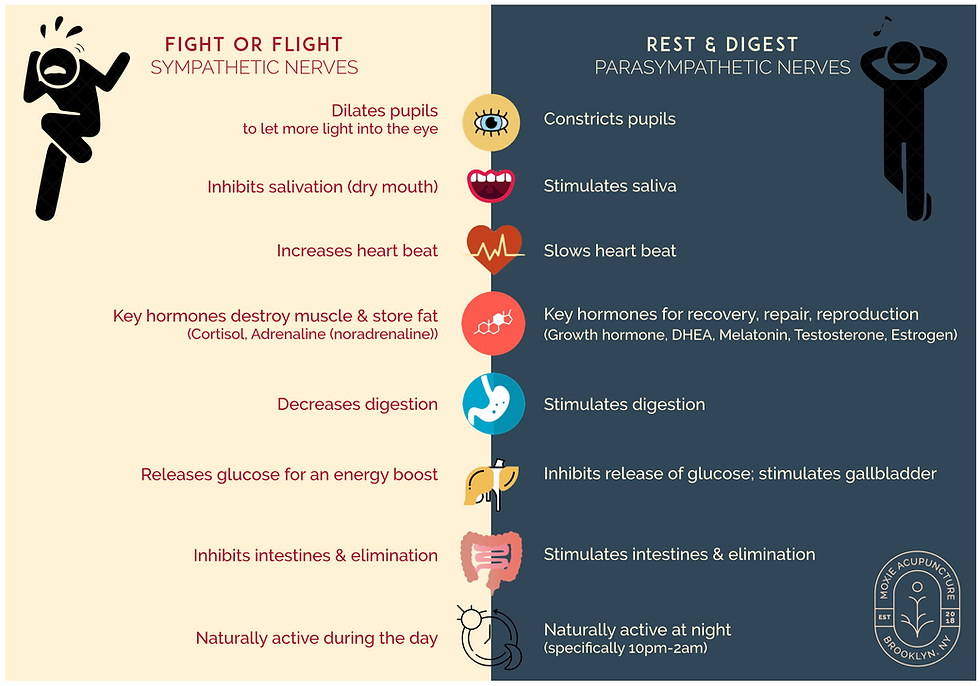Hack Your Nervous System With This Easy Breathing Exercise
- SooHee Straub
- Jan 23, 2020
- 3 min read

Your body has a brilliant auto-pilot system (the autonomic nervous system) that controls basic life-critical functions without you having to think about it - such as breathing, and regulating your heart rate, blood pressure and temperature.
On auto-pilot, your body operates in two modes: fight-or-flight (the sympathetic system) or rest-and-digest (the parasympathetic system).
Your fight/flight system fires up to respond to dangerous or stressful situations: breathing speeds up, heart rate increases, blood pressure rises. Stress hormones like cortisol flood your body and glucose is shot into the bloodstream to boost vigilance, energy and rapid reaction. Blood is shunted away from your organs and towards the limbs in case you need to run.
When the rest/digest system is dominant, your breathing slows, your heart rate drops, your blood pressure lowers as the blood vessels relax. Your body is put into a state of calm, where it can use the body’s resources to focus on digestion, reproduction, and restorative healing. (When your body thinks it's life is in danger, it de-prioritizes eating, sleeping, and procreating.)
The thing about the fight/flight response is that it doesn’t wind down on its own. In fact, it can’t.
The rest/digest system has to kick in to calm the body down, and help it settle back to normal levels.
Many of us, though, are stuck in this fight/flight mode.
Modern living has us on hyper drive. We don’t get enough sleep or exercise (exercise helps metabolize excess stress hormones). Chronic, daily, unrelieved stress has gotten our brain super efficient at stress and it takes less and less to trigger a stress response. (Like having a meltdown because you overcooked the pasta or a tantrum because your express train is going local…)
Some other signs that your body is having a hard time switching off the stress response:
Sleep issues, anxiety
Blood sugar issues, digestion issues
Sexual dysfunction, infertility
Poor concentration or brain fog
Getting sick easily
Chronic inflammation
Elevated cortisol levels over a prolonged time will set off a cascade of hormonal disturbances that damage your body.
What can we do?
Manage your stress.
Exercise.
And breathe...
Breathing is an incredibly useful and effective tool to hack your nervous system.
Breathing is (thankfully) one of the bodily functions that we don’t have to remember to do, but it’s also something we can consciously control. Which can then, in turn, affect the other autonomic functions - like our heart beat, blood pressure, and our stress hormones. Slow, deep breathing can send messages to the brain (by the vagus nerve) that we’re safe. It’s a form of respiratory biofeedback.
By lengthening your exhale, you can manipulate your respiratory feedback and hack your nervous system to ease your brain/body from its fight-or-flight mode into its rest-and-digest mode. That’s probably also why deep breathing is at the core of meditation and other self-centering practices.
Try this
I like to start with a 2-count inhale and a 4-count exhale, and gradually work up to 4-in / 8-out.
I keep to a 1:2 ratio for inhale/exhale - said another way, I exhale for twice as long as my inhale.
Use deep belly breathing. If it helps, place one hand on your stomach and the other on your chest to make sure you’re expanding your abdomen with your deep and even breaths - and that your chest / rib cage is fairly still.
I try to do this at least twice daily for about 5-minutes to bookend my day: once upon waking (or in the shower if you’re like me and are a zombie in the mornings) and again at night in bed before I fall asleep.
I also take breathing breaks throughout the day - particularly when I find myself a little worked up, or I notice that I’m holding my breath. I find that it only takes about 4 rounds of inhales/exhales before you can feel your body easing into a parasympathetic state.
I also do the 2:4 count breathing while I’m walking (two steps on the inhale and four steps on the exhale). It’s a nice cadence for me, and it’s a pleasant and convenient way for me to clear my head.
I’d like to sign off this post with a heady reflection that I think I understand:
"Breath has patterns. Schemes create behavior. Breath is a behavior. Behavior represents the person. Breath reveals the person."
Sources:
The Influence Of Breathing on the Central Nervous System
Bruno Bordoni-Shahin Purgol-Annalisa Bizzarri-Maddalena Modica-Bruno Morabito - https://www.ncbi.nlm.nih.gov/pmc/articles/PMC6070065/




Comments